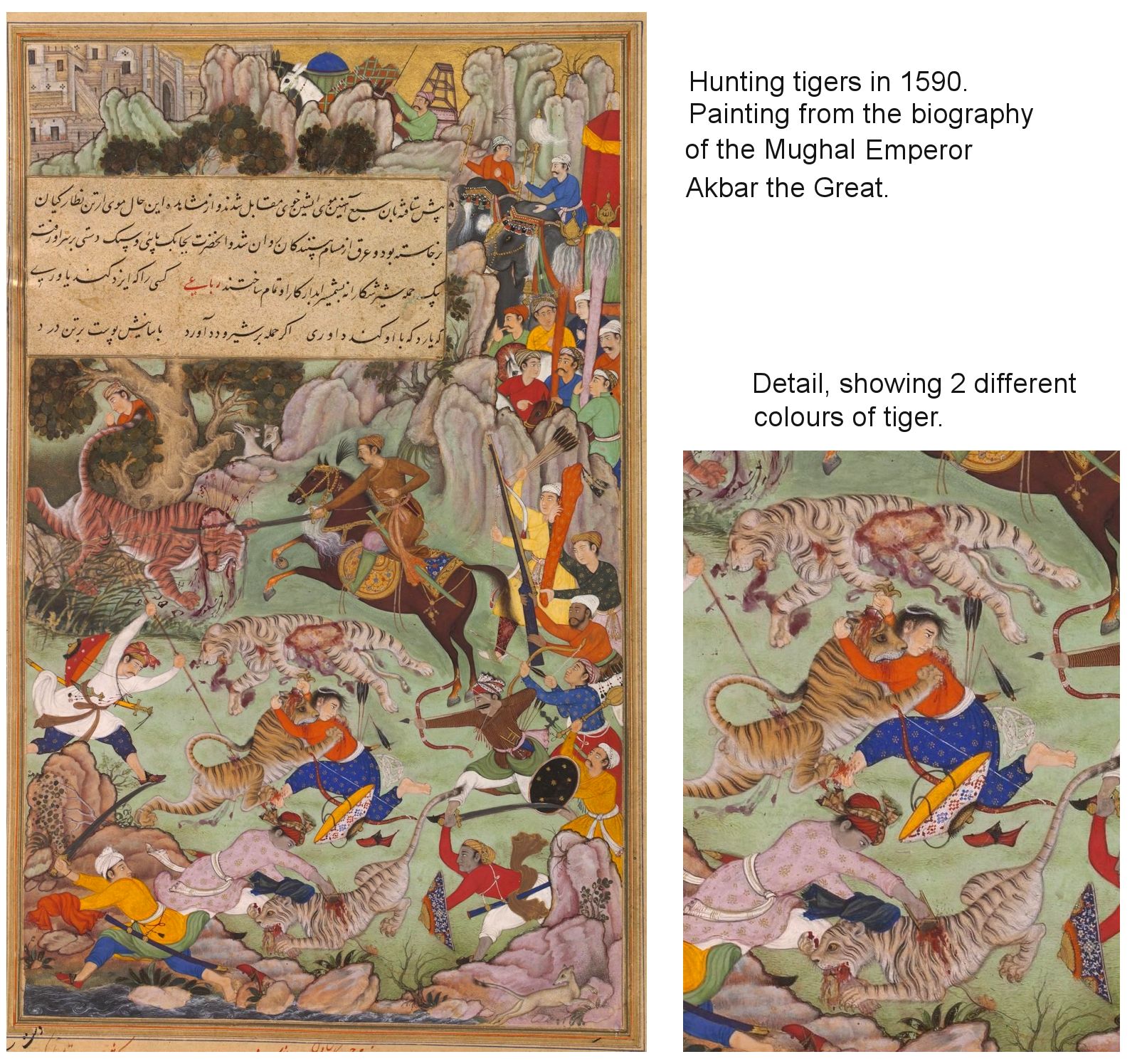
|
WHITE TIGERS UP TO 1899 |
Historical quotations are credited and are in the public domain. Original text is licensed under the GFDL. I am grateful to Paul McCarthy, Mary Ann Howell, Catherine Walsh and Jerry Blackman for researching and providing extensive material, information and corrections on white tigers and for genealogies.
"White gene" vs "Inhibitor gene."
Although these pages refer to "white genes," white tigers have the genes for normal orange colours, but those genes are switched off by a recessive "inhibitor gene." When a tiger inherits 2 copies of the inhibitor gene, the normal orange colour is suppressed. In general parlance, it's simply easier to refer to "white genes."
The white tigers found in zoos outside of India are mostly of mixed Bengal and Amur ancestry and should be considered a man-made "breed" i.e. they arose in the wild due to recessive genes, but have been selectively bred for the colour trait in captivity. Tigers with mixed genetic ancestry have little conservation value, but those of pure Bengal ancestry carry important genetic diversity for the Bengal tigers a long as they are allowed to occur in the gene pool at a natural rate and are not selectively bred for their colour. White tigers with dark brown or reddish-black stripes were recorded in the wild during the Mughal Period from 1556 - 1605 AD. As many as 17 instances of white tigers were recorded in India between 1907 and 1933 in several separate locations: Orissa, Bilaspur, Sohagpur and Rewa. The Bombay Natural History Society recorded 17 white tigers shot in India between the years 1907 and 1933. One was shot in the Dhenkanal State, Orissa, in 1909 and described in the Society's Journal The ground colour was pure white and the stripes were of a deep reddish black colour" Another was shot in the Bilaspur District of the then C.P. in 1910 and described in the Journal as "cream coloured throughout but paler on the head and the stripes were chocolate brown". That shot in the district of Bhagalpur in Bihar, and was as "pure white with black stripes on her body and russet brown ones on the tail. The taxidermists to whom the trophy was sent report that during the year 1926 they received three white tiger skins including mine (mine was shot on December 6, 1926), but my skin is the only pure white one, the other two being cream coloured."
It is commonly believed that white tigers only occur among Bengal tigers. Korea and Northern China, but not Siberia, were known for white tigers in the wild. The mutation may have also occurred in pure-bred Amur tigers. The Amur tiger (as it is now called) was previously split into the Manchurian, North China, and Siberian subspecies. The smaller Korean tiger was also previously recognized as a subspecies. The Siberian, Manchurian and Korean subspecies have been combined into the Amur subspecies, which is also known by its historical name of Siberian or North China tiger. White tigers have been reported in northern China, in the geographic range of the Amur tiger and seem to have occurred in the Indo-Chinese, Sumatran and Javan subspecies. White tigers have not been reported amongst the South China, Caspian or Bali tigers. The blue tigers reported in China and on the North/South Korean border region may have been due to a manifestation of the same mutation. White tigers form part of tradition in some regions. In China the white tiger was revered as the god of the West. The white tiger is represented on the South Korean flag in the Yin and Yang emblem, the white tiger as evil opposite the green dragon for good. According to Indian superstition, the slayer of a white tiger would die within a year and the white tiger was regarded as the incarnation of a Hindu god. Sumatran and Javan royalty claimed descent from white tigers, and white tigers were regarded as the reincarnations of royalty. White tigers are also known as Ice Tigers, not because of their habitat, but because of their "glacial" appearance.

This painting from around 1590 depicts 4 tigers, 2 of which appear to be white tigers when compared to the 2 orange tigers shown (Akbar, who is depicted hunting the tigers in the painting, also had a white cheetah). This appears to be the first record of white tigers. The Gwalior tiger hunt painting is from the "Akbarnama" of Akbar the Great, the Moghul Emperor of India. It depicts Akbar hunting tigers while returning from Agra to Malwa in 1561. There is some debate over whether the light coloured tigers are white tigers since light colored tigers are not uncommon. At the Gwalior hunt, Akbar killed a tigress and five subadult cubs.
"A Chinese Bestiary - Strange Creatures from the Guideways Through Mountains And Seas," by Richard E. Strassberg, is a translation of an old Chinese text and refers to "Two hundred twenty li farther west is the Mountain Where Bird and Rat Share a Hole. On its heights are many white tigers and much white jade. The prancing white tiger is one of the four directional animals (representing west) of ancient China, along with a black tortoise entwined with a snake (north), a red bird (south) and a green dragon (east). These were painted inside tombs and the sides of coffins as guardians as well as a form of compass for the dead. The animals were also associate with elements; the white tiger symbolising metal and, therefore, with power. During the Zhou Dynasty (1046 256 BC), the metal weapons buried in a king's grave were said to metamorphose into a white tiger three days after his burial, and to remain crouching on the grave to protect the king's spirit from evil creatures. The white tiger was seen as the king of all animals and the lord of the mountains. This cannot be taken as reliable evidence for the existence of white tigers in China; the 4 directional animals include a mythical green dragon.
According to "The Book Of The Tiger" by Brigadier General R. G. Burton (1933) "These Gonds worshipped the Tiger God among other deities of their animist beliefs. . . . The Divine Being in the form of an immense White Tiger, when invocations accompanied by the sacrifice of a bullock, a goat, or a fowl, have been made to invite his assistance, prowls round the afflicted area throughout the night, and expels the beast whose depredations have been causing loss to his aboriginal proteges or their flocks and herds. however others believed that white tigers were maneaters, a view mentioned by Sally Walker of the Zoo Outreach, in her article in Zoo's Print White Tigers The Indian Point Of View, that the casual way that Jim Corbett refers to a white tiger in "Man Eaters Of Kumaon" suggests that it was nothing out of the ordinary. Corbett's film of a white tigress, with 4 nearly grown orange cubs, is suggestive of a white bodied tigress with an orange head.
An oil painting of an apparently albino tiger head by Robert Home (1752-1834) is on display at the Hunterian Museum, London, UK. It was painted some time between 1790 (Home's arrival in India) and 1807 (when it was presented to the Hunterian Museum, London). The painting was listed in William Clift's catalogue of museum exhibits of 1816 as "The Head of a White Tyger, which was killed in India; and was by many imagined to have been a Lioness, but in the skin might be perceived the Stripes of the Tyger although very faint, as to be easily overlooked except by very close observation in a proper light. Painted in India by Robert Home." Home's painting shows only the tiger's head. The eye, which might have been diagnostic of either albinism or leucism, has been removed however the nose and lining of the mouth are black, indicating that this is not an albino tiger, but a stripeless white tiger. The skin does not appear to have been preserved as a taxidermy mount or study skin.
In India, Vice-Admiral Sir Edward Pellew, Commander in Chief of the East Indies Station from 1805-1809, acquired a young male white tiger that grew into a tame adult. It was "perfectly white, and the second that has ever been seen in India". he brought this back to England at the end of his service in India and its arrival was heralded in many newspapers. " Vice-Admiral Sir Edward Pellew, Bart., landed last week from the Culloden a beautiful full-grown hunting tiger. It was so tame that a seaman led it through the streets with a small rope, and the children stroaked it over the back without the least danger of being hurt." (Royal Cornwall Gazette, 22nd July 1809); "Yesterday was landed from the Culloden, of 74, vice-admiral Sir E. Pellew, and passed at the custom-house, a beautiful hunting male tiger, a present for-some nobleman. Also an elegant tiger cat, which was so tame as to be led to the custom-house, and was actually patted on the back by the children as he passed on, without the usual tiger-like disposition of ferocity." (Exeter Flying Post, 27th July 1809). There are many other reports of this tiger's arrival as the story was picked up by newspapers around the country.
This gift to King George III was mentioned in the Oxford Journal, Saturday 5th August, 1809: "On Thursday [3rd August] was safely lodged in the Tower a most curious milk-white tiger, being a present from Sir Edward Pellew to the King." This was the Tower Menagerie where the exhibits were confined to cramped cages for public display, and often fed unsuitable diets the public could gain free entrance by providing cats and dogs to feed to the lions and tigers confined there. The state of the place was described in "Journal of a Tour and Residence in Great Britain, During the Years 1810 and 1811," by Louis Simond (1815). An entry for May 1811 reads "the menagerie, which is small, ill-contrived and dirty. The animals look sick and melancholy. The most curious of them was a white tiger, lately brought from India by Sir Edward Pellew, and so tame that the sailors used to pare his claws regularly during the voyage, and on his landing, he was led through some of the streets of London, or rather followed like a dog." In 1815, the menagerie records there was only a single tigress at the Tower. It appears to have been returned to Pellew because a tiger was mentioned by his wife, Susan, in a letter to him in June 1811.
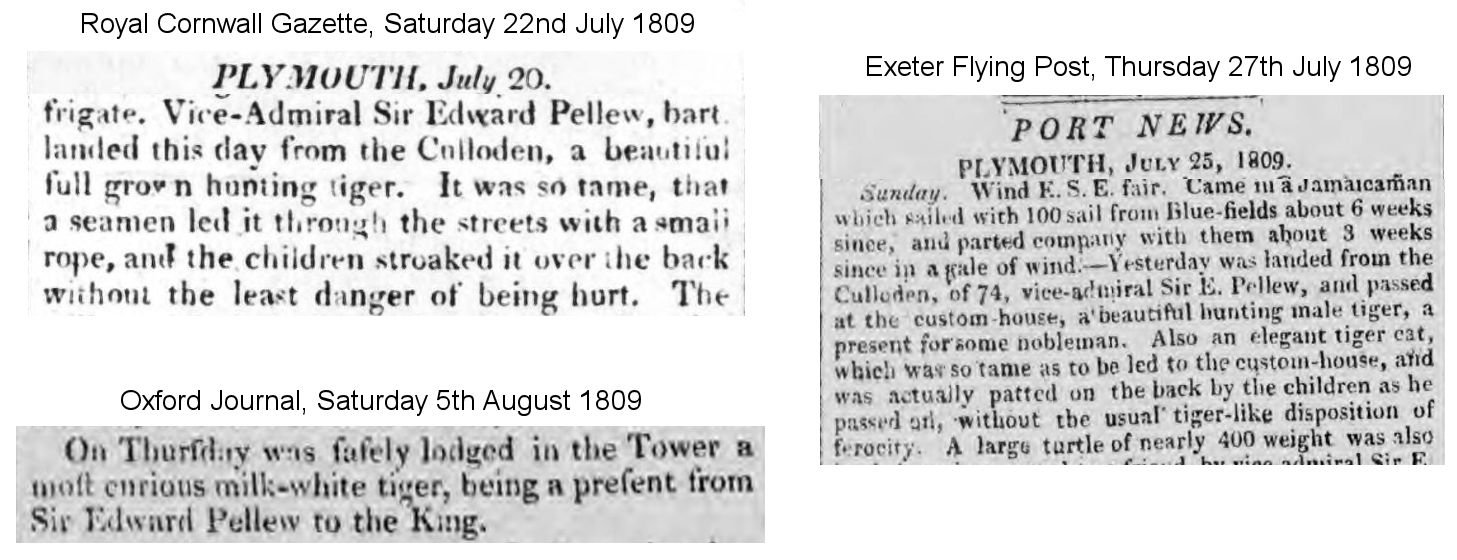
A white tiger was reportedly exhibited at the Royal Menagerie at the Exeter Exchange (known colloquially as Exeter Change) in London in or around 1820. At first glance this sounds like Sir Edward's white tiger, now in its teens. Although it styled itself the "Royal Menagerie," so did most of the travelling menageries at that time. The real Royal Menagerie, of course, was at the Tower of London (until 1831 when it removed to the Zoological gardens in Regent's Park). Shore, Wombwell, and Drake all referred to their travelling animal displays as "Royal Menagerie;" so the term probably just meant it contained large, exotic animals. However the numerous adverts in the press make no mention of a white tiger ever being exhibited at Exeter Change. The Exeter Change menagerie changed hands several times (from Mr Pidcock to S. Polito to Mr Clark and then to Mr Cross) a number of times and the live animals were periodically auctioned off, "many of the animals were sold to the itinerant showmen, and who keep such for amusement" (Morning Advertiser, 22nd March 1810). In 1829 the Exeter Change was closed to make way for redevelopment and the animals went first to King's Mews, Charing Cross (described as a dungeon beneath a watch-house), and then in September 1831 to the Surrey Zoological Gardens. During this time the collection boasted a lion-tiger, a black tiger and Bengal tiger, but never a white tiger (either living or taxidermy).
One possible answer to the confusion regarding the Exeter 'Changer white tiger is that Pellew later became Lord Exmouth (1st Viscount Exmouth), and it's possible that references to "Exmouth's white tiger" somehow became garbled into "Exeter's white tiger" (i.e. Exeter Exchange). I camne across one mention of a suffed white tiger being displayed there in 1820, but no corroborating information. Menageries at the time often displayed taxidermy as well as live animals.
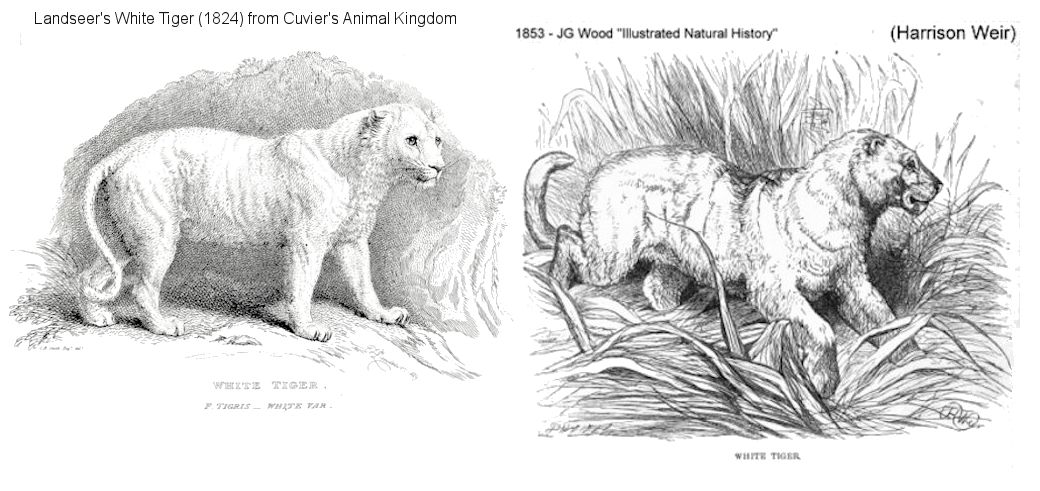
In "A geographical, statistical and historical description of the district ... of Dinajpur," by Doctor Francis Buchanan (Hamilton), published in 1833, page 134 states: "It was in this district that a white animal of this kind was killed some years ago, the skin of which having been sent to Europe by Lord Wellesley, occasioned a dispute, whether it was that of a lion or tiger. No such animal has been seen before or since. Mr Tucker, an indigo planter of this district, declares that in a wood near Lalbazar he saw an animal resembling a tiger in size and colour, but it had a mane like a lion. I offered a considerable reward for it, dead or alive, but without success: this however is no proof of its not existing, as I found the people totally unwilling to bring even fish, plants, or any other natural production." Francis Buchanan (aka Francis Hamilton) was a Scottish physician and botanist who served in the Bengal Medical Service between 1794 and 1815. He surveyed several regions of India, collecting information about flora, fauna and archaeologyand between 1807 and 1814, he made a detailed survey 25 volumes - of the Bengal region for the British East India Company, though this was not published for many years. In 1818, Buchanan changed his name to Hamilton after his brother died and Francis inherited the estate of his mother, Elizabeth Hamilton.) Later authors often based their own gazetteers on Buchanan's / Hamilton's reports.
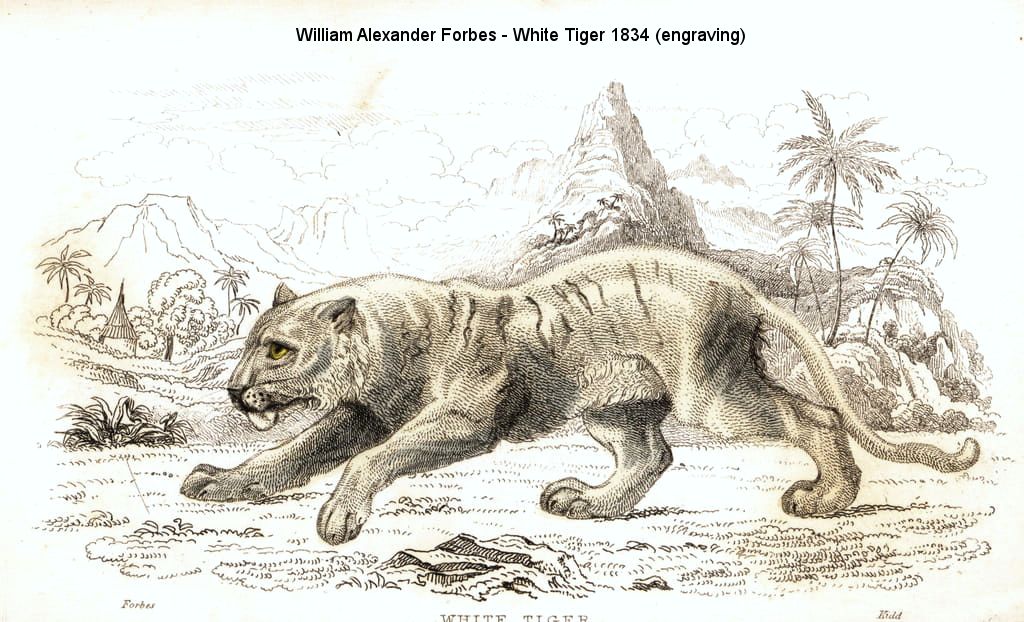
In "The History, Antiquities, Topography and Statistics of Eastern India (Bhagulpoor, Goruckpoor, and Dinajepoor Vol 2) "by Robert Montgomery Martin, published in 1838 , there are references to white tigers on pages 501 (Gorakhpur) and 761 (Dinajpur). These are based on Francis Buchanan's reports. "[Goruckpoor] The natives of this district reckon 4 kinds of tiger (Vagh). 1st, Babbra, which is white, has very long hair about the head, and is the largest of all. It is very rare, nor have I met with anyone that has seen it, but I heard that one was killed by Digvijay Raja of Bhewopar some time before the English took possession, and the animal is said to be occasionally seen by the cowkeepers. From the circumstances of the long hair about the head, and of the animal having no spots, I should have imagined that it was the lion; but the people all say that the colour is pure white. It neither attacks man nor domestic animals. The animal killed in Dinajpoor, and of which the skin was sent by the Marquis Wellesley to Sir Joseph Banks, was probably of this species. 2nd Nongiyachhor or the royal tiger, which lives chiefly among reeds, or in the thickets." and "[Dinajepoor] It was in this district where a white animal of this kind was killed some years ago, the skin of which having been sent to Europe by Lord Wellesley, occasioned a dispute, whether it was that of a lion or tiger. No such animal has been seen before or since."
At the time it was surveyed by Buchanan, the Gorukhpoor district extended to the Himalayan foothills, and eastwards over the Bihar border. Bihar became a hot-spot for white tiger sightings in the early 20th century. "A Gazetteer of the Territories Under the Government of the East-India Company: And of the Native States on the Continent of India, Volume 2," by Edward Thornton (1858) enumerates the four Indian big cats in its chapter on Goruckpore, page 384: "The natives enumerate 4 species of the large feline tribes: 1. the Nongiyachor or Royal tiger; 2. the Babbra, which is white, has very long hair about the head and exceeds the former in size 3. The Cheeta or hunting leopard and 4. the Tenduya, a small spotted feline creature, living in trees." This is repeated in George Bradshaw's "Hand-Book to the Bengal Presidency, and Western Provinces of India" (1864), page 195: "[The Goruckpore District] abounds with tigers, not so numerous as formerly, on account of the havoc which European hunters have made among them ..There are several species, viz the Nongujachor, or Royal Bengal tiger; the Babbra or white and long-haired headed, very large; the Cheeta or hunting leopard; the Tenduya, which lives in trees and is spotted."
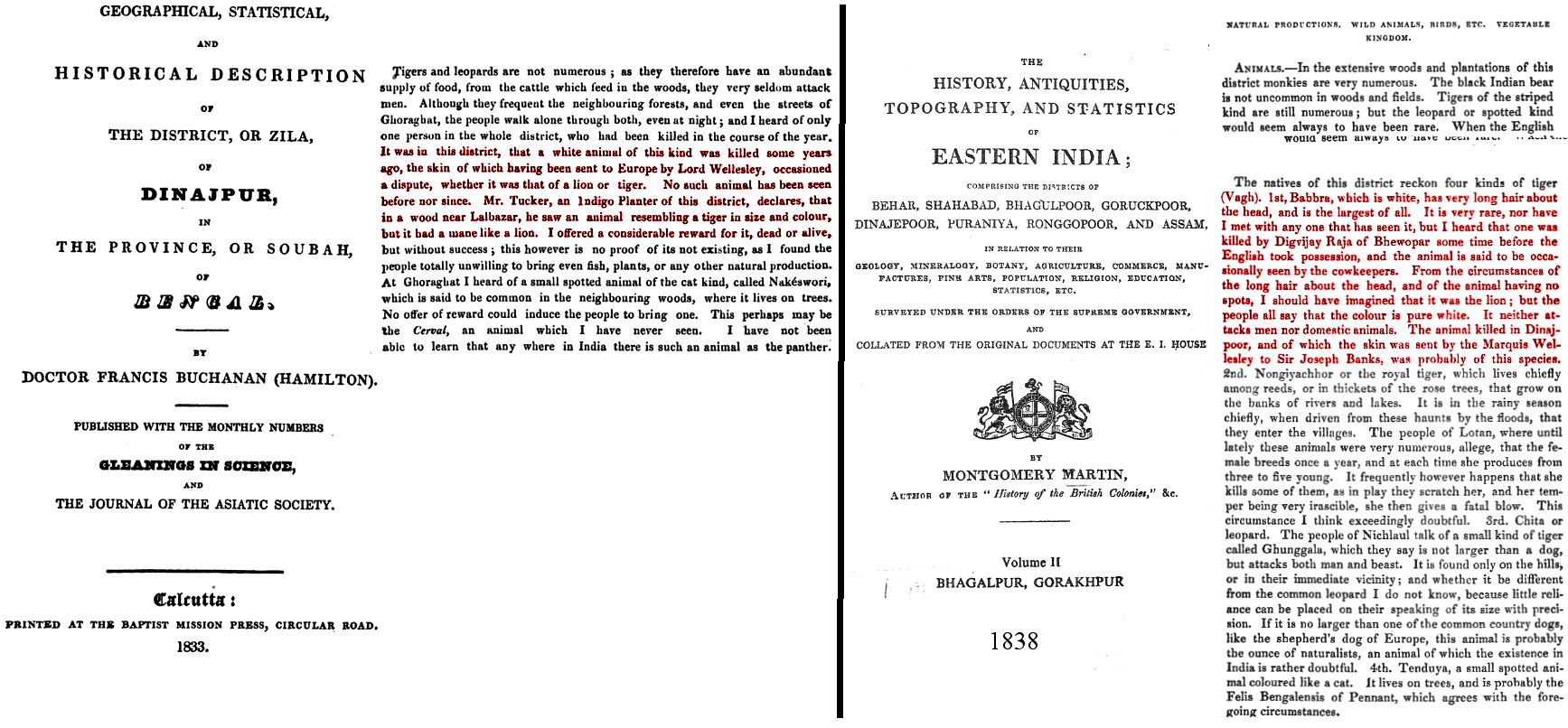
"Babbra" could either be Anglicized version of "Babr," the 16th Century Mughals' Farsi/Dari (Persian languages) word for Tiger, or be a rendering of the Hindi "babbar" (or "babar") meaning lion. The class-conscious British had a long association with the Mughal elite and might prefer the Mughal term. The usual Mughal term for lion was "shir," though a striped shir' was a tiger. As Persian words were assimilated they became "babbar-sher" (lion), and "sher" (usually tiger, occasionally lion). A leopard was "tendwaa" and a panther was "baghera." The Mughals depicted pale-striped white tigers being hunted near Gwalior around 1590. The Sanscrit term "vagh" (bagh, "big cat") could be prefixed by an adjective when a more specific description was needed. "The Book Of The Tiger" by Brigadier General R. G. Burton, 1933 says "It has been suggested that there is no Sanscrit word for Tiger. This is, however, erroneous, for we have in Sanscrit the word vyaghra, and chita vyaghra for spotted Tiger or leopard. A writer in the 'Oriental Sporting Magazine' says that the Tiger was called hyaghro or bagh in the Sundarbans. These words occur in Hindi, a language of Sanscrit origin, bagh or zoagh being a Tiger, and chita bagh, a leopard; and sinh, lion, but often bagh is used indiscriminately for both animals, and even untia bagh for lion, untia being 'camel-coloured.'" In addition to Burton's explanation, "boga bagh" meant white tiger, while "chita bagh" was the "hunting leopard" i.e. cheetah.
(In a letter to Country Life, 16th August, 1924, pg 267, G.F. Sheppard elaborated on the untia bagh: Sir,- Your picture of the lion-tiger hybrid presented by H.H. the Jam Sahib to the Zoo might well represent what used to be known as the "maneless lion" of Guzerat. There are several records of this animal, which was supposed to be a distinct species of Felis leo. In 1783 Captain Smee of the Bombay Infantry shot eleven of them near Cutch. They were known as the "untia bagh," being camel-coloured. (Proceedings of the Zoological Society). About the same time Sir Charles Malet, then "President" of Cambay, during a hunt in the same vicinity shot one of these beasts, "camel-coloured, and esteemed the fiercest and most powerful of its tribe" (Forbes' "Oriental Memoirs"). I had read in the Abba Dubois' Tours a mention of a similar beast, and when in camp near Cambay fifty years ago the Vaghris told me of an animal honey-coloured, whether lion or tiger they did not know. I could get no more information, and was never again in the neighbourhood.)
A white big cat without spots (or without markings) rules out the leopard [tendwaa], cheetah [chita], snow leopard, and striped tiger. In the early 19th century, Asiatic lion ranged from eastern Pakistan as far east as Palamau and Rewa, in Madhya Pradesh, India. It once extended to Bengal in the east and the Narmada River in the south, but declined due to hunting (Kinnear (1920) and Blanford (1889)). Although pure white leopards were later shot at Dumraon in Bihar and Madhya Pradesh according to Divyabhanusinh (JBNHS, 1993), they are smaller and lack long hair about the head. The babbra was rarer than the striped tiger and the leopard. The people (plural) all described it as pure white; a colour not reported in Asiatic lions. "One was killed by Digvijay Raja of Bhewopar [Bhauwapar, in Goruckpur] some time before the English took possession [in 1801]." Additionally, "the animal killed in Dinajpoor [. . .] was probably of this species." Buchanan had first hand knowledge of that Dinajpur white tiger. In "The East-India Gazetteer, Vol 1. 1828 by Walter (MRAS) Hamilton, page 515 states [Dinagepoor] In this district a white animal of the tiger kind was killed some years ago, the skin of which being sent to Europe by Lord Wellesley, occasioned a dispute whether it was that of a lion or a tiger. No such animal had been seen before, nor has it been seen since." and he references Dr Buchanan. Wellesley's white tiger skin sways the identification of the babbra in favour of a white tiger.
Wellesley's white tiger was also mentioned in "A geographical, statistical and historical description of the district [. . .] of Dinajpur, by Doctor Francis Buchanan," published in 1833. Page 134 states: "It was in this district that a white animal of this kind was killed some years ago, the skin of which having been sent to Europe by Lord Wellesley, occasioned a dispute, whether it was that of a lion or tiger. No such animal has been seen before or since. Mr Tucker, an indigo planter of this district, declares that in a wood near Lalbazar he saw an animal resembling a tiger in size and colour, but it had a mane like a lion. I offered a considerable reward for it, dead or alive, but without success: this however is no proof of its not existing, as I found the people totally unwilling to bring even fish, plants, or any other natural production." The skin of the Dinajpur white tiger was sent back to Sir Joseph Banks in England by Lord Wellesley.
Between 1803-4 Buchanan was surgeon to Lord Wellesley, Governor General of India, in Calcutta, and was made the Director of his Natural History Project of India. His role was to study the animals in the collection at Barrackpore, and collate zoological information and specimens received from other areas. Buchanan examined the skin of the white tiger killed in Dinajpur and wrote about it in a letter to Sir Joseph Banks (January 1804). The letter is contained in "The Despatches, Minutes and Correspondence of the Marquess Wellesley During His Administration in India. Ed. by Montgomery Martin" (page 674, Minute of the Governor-General on the Natural History of India. Fort William. July 26 1804.) The Dinajpur tiger skin was evidently snow-white; it "occasioned a dispute whether it was [. . .] a lion or tiger". Buchanan noted that none "has been seen before or since," which may have been true of Buchanan and Wellesley, although there were more reports of snow-white tigers from that region and time, and also from further North-East.
The artist Robert Home was in Calcutta from 1795-1814 and made numerous paintings of Indian wildlife. These included an oil painting of the "head of a white tiger" (dead), and a watercolour of the whole animal. Both paintings, along with the skull of the white tiger, were presented to the Royal College of Surgeons in London in 1807 by Home's brother. If this was the tiger that was killed in Dinajpur, Sir Joseph Banks had only the pelt for Wellesley, while Home had the head and skull. According to the RCS, "This [painting] was listed in William Clift's catalogue of 1816 as: The Head of a White Tyger, which was killed in India; and was by many imagined to have been a Lioness, but in the skin might be perceived the Stripes of the Tyger although very faint, as to be easily overlooked except by very close observation in a proper light."
In "The Pictorial Museum of Animated Nature" by Alan L Wolfe (1844), it was noted "Individuals are sometimes exhibited of a very pale colour, with the stripes very obscure, and Du Halde says that the Chinese tiger (Lou-chu or Lau-hu) varies in colour, some being white, striped with black and grey." It is possible that some white tigers captured were of the Indo-Chinese race which were previously classed as Bengal tigers.
In the Evening Mail of Friday 5th June, 1846, is part of a report (dated 29th March) from the French squadron in the China Seas. Rear-Admiral Cecille had procured a black tiger with white stripes at the peninsula of Malacca, and it was destined for the Royal Menagerie of Paris. This suggests a white tiger with pseudomelanism.
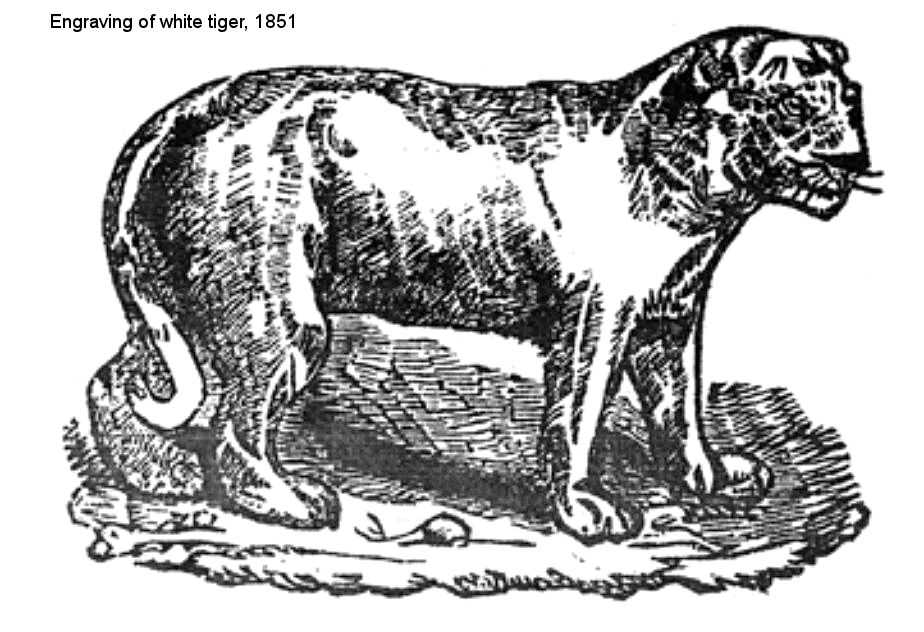
There is then a gap in the reports of white tigers. They were not considered importance in the early-to-mid 1800s, at least not in comparison to commerce, military, government and colonial affairs. Buchanan's employer, the British East India Company, was a trading company and its interest in natural history was related to profit. Botany was the dominant science at the time, and tigers were primarily considered a pest, or a target for paying trophy hunters. There may well be more reports of white tigers hidden in archives of correspondence. As more and more archives are scanned and put online, more such reports are surfacing.
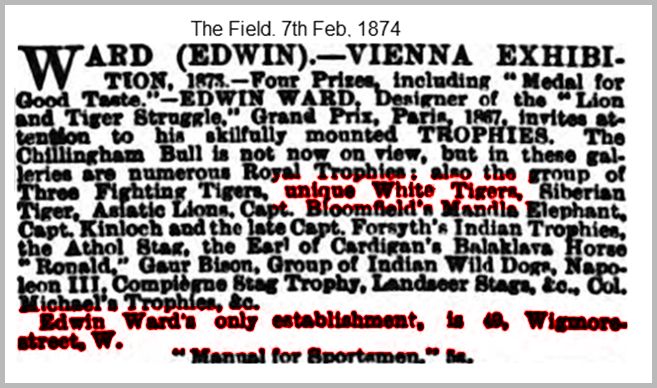
In "The Large and Small Game of Bengal an the North-Western Provinces of India" by Captain J. H. Baldwin, F.G.S., Late Of H. P. Bengal Staff Corps, published in 1876, the author writes, "Some assert that there are two or three species of tiger in India alone, and that the animal found in the Sunderbans is larger than, and of a different species from his Central-Indian brother, but I do not think this is the case. Undoubtedly there is much diversity in colour, shade, size, and general appearance among tigers. I have seen skins of every shade: some, light yellow with numerous and narrow stripes, others, very dark yellow or rufous, with broad transverse bars of black. Some have a kind of double row of stripes as it were, some have small yellow spots in addition to the stripes. I have seen the skin of a white tiger (this however is a great rarity), and lastly, I have often seen skins of old animals very much faded, and the stripes almost imperceptible. No two tiger skins are ever I believe exactly alike. Yet, as I said before, in spite of skins differing in size, colour, and number of stripes, they all belong to one and the same species of tiger. "
There is an account of the different varieties of Indian tiger in "Highlands Of Central India - Notes On Their Forests And Wild Tribes, Natural History, And Sports," by Captain J. Forsyth (1889): Native shikaris recognise more or less two kinds of tigers, with the names I have given above [lodhia bagh, and oontia bagh, the latter being older and heavier "with a faintly striped coat resembling the colour of a camel"]. It may be matter for speculation which is cause, and which is effect. Is it that as tigers grow old and heavy they take to the easier life of cattle-lifting? Or has the difference of their pursuits, continued for generations, actually resulted in separate breeds, each more adapted for its hereditary method of existence? I, myself, believe the former to be the truth, and that there really is only one variety of tiger in all peninsular India. It is only to extreme specimens that the above distinctive names are applied; and the great majority are of an intermediate character, and not distinguished by any particular name. The larger and older the animal, the more yellow his coat becomes, and the fainter and further apart are the stripes. Small tigers are sometimes so crowded with the black stripes as almost to approach the appearance of a melanoid variety. A few specimens of white tigers with fulvous stripes have also been mentioned, though I have never heard of one in Central India. The tiger, like all animals that I am acquainted with, is subject to slight variations of appearance and conformation amongst individuals and local circumstances, and perhaps "natural selection," may tend to give the race something of peculiarity in different localities. But none of these has as yet, I believe, reached the point of even permanent variation.
In March 1889 a white tiger was shot in upper Assam and is recorded by Lydekker. Lt.-Col. FT Pollok wrote in his book "Wild Sports of Burmah and Assam" (1879) "Mr. Shadwell, Assistant Commissioner in the Cossyah and Jyntiah Hills, also had two skins quite white, but when turned about in a strong light just a faint mark or two could be seen to indicate that they belonged to a tiger at all." A white tiger from Poona was reported in the "Proceedings of the Zoological Society of London" in 1891. Messrs. Rowland Ward wrote in "Records of Big Game" of a number of white tigers shot in India, including one was shot in Rewa State and presented by the Maharaja to King George V. A male white tiger from the Lechuar Jungles of Bihar was exhibited in the Indian Museum, Calcutta; it was cream with light brown stripes (probably due to fading) and the glass eyes were normal coloured.
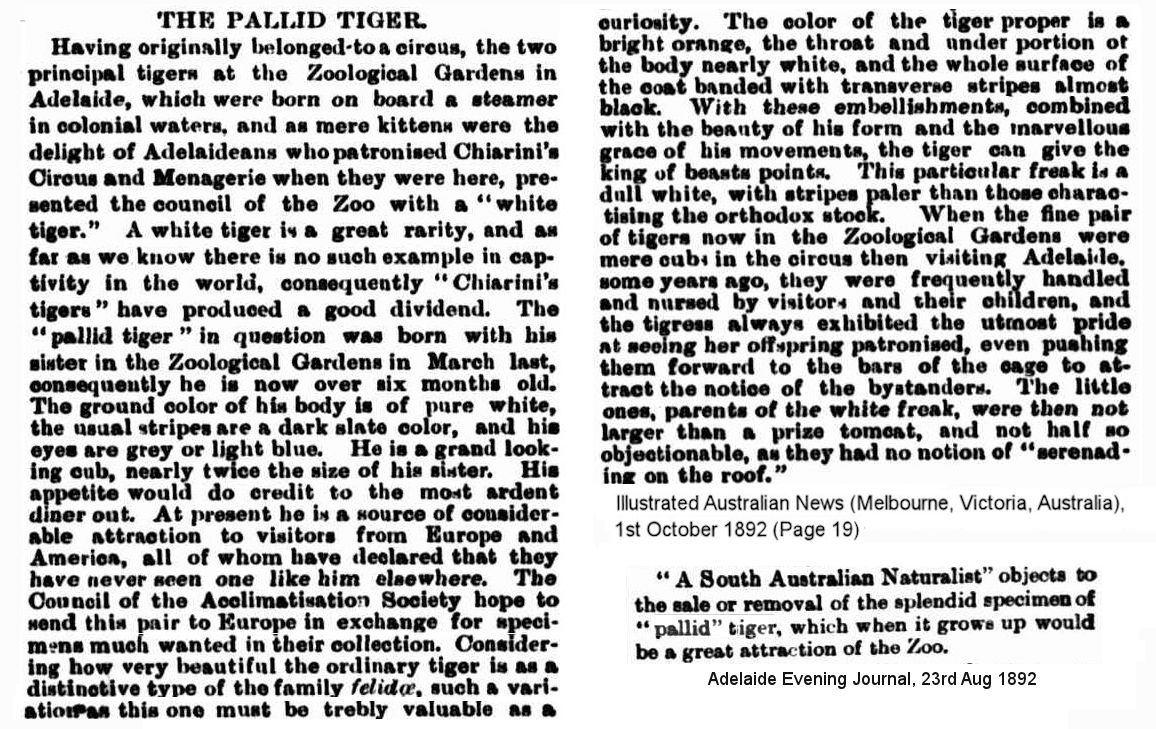
In 1892, and again in 1894, a white tiger cub was born in Australia to a pair of ex-circus tigers.
"Society news from the [Adelaide] Zoological Gardens is to the effect that the white tiger held a largely attended levee last week. . .. The baby white tiger and his tawny twin brother are growing splendidly, and as they 'take the air' on Mondays and Tuesdays they can be seen to special advantage." (South Australian Register 7 Jun 1892 - The Zoo) The cub appears to have been born in March 1892.
The Illustrated Australian News, 1st October 1892, Page 19 provides another early report: THE PALLID TIGER. Having originally belonged to a circus, the two principal tigers at the Zoological Gardens in Adelaide, which were born on board a steamer in colonial waters, and as mere kittens were the delight of Adelaideans who patronised Chiarini's Circus and Menagerie when they were here, presented the council of the Zoo with a "white tiger." A white tiger is a great rarity, and as far as we know there is no such example in captivity in the world, consequently "Chiarini's tigers" have produced a good dividend. The "pallid tiger" in question was born with his sister in the Zoological Gardens in March last, consequently he is now over six months old. The ground color of his body is of pure white, the usual stripes are a dark slate color, and his eyes are grey or light blue. He is a grand looking cub, nearly twice the size of his sister. His appetite would do credit to the most ardent diner out. At present he is a source of considerable attraction to visitors from Europe and America, all of whom have declared that they have never seen one like him elsewhere. The Council of the Acclimatisation Society hope to send this pair to Europe in exchange for specimens much wanted in their collection. Considering how very beautiful the ordinary tiger is as a distinctive type of the family felidae, such a variation as this one must be trebly valuable as a curiosity. The color of the tiger proper is a bright orange, the throat and under portion of the body nearly white, and the whole surface of the coat banded with transverse stripes almost black. With these embellishments, combined with the beauty of his form and the marvellous grace of his movements, the tiger can give the king of beasts points. This particular freak is a dull white, with stripes paler than those charactising the orthodox stock. When the fine pair of tigers now in the Zoological Gardens were mere cubs in the circus then visiting Adelaide, some years ago, they were frequently handled and nursed by visitors, and their children, and the tigress always exhibited the utmost pride at seeing her offspring patronised, even pushing them forward to the bars of the cage to attract the notice of the bystanders. The little ones, parents of the white freak, were then not larger than a prize tomcat, and not half so objectionable, as they had no notion of "serenading on the roof." This indicates that the parents of the white tiger were a brother-sister pair.
It seemed that the zoo did not intend to keep the white tiger, perhaps because the proceeds of selling the unusual animal would help towards its heavy running costs. The Adelaide Evening Journal, 23rd August 1892 tells us that " A South Australian Naturalist' objects to the sale or removal of the splendid specimen of "pallid" tiger, which when it grows up would be a great attraction of the zoo." Although valuable, the infant tiger was not in the best of health, most likely due to the standard of husbandry at the time. "Mr. Minchin, the enthusiastic Director of the Zoological Gardens, is very proud of a white tiger which was recently born in captivity there, and he feels very sad because its health is none of the sturdiest. I am told that the animal is very valuable. Its father and mother are, I believe, brother and sister, which probably accounts for the color." (The Mount Barker Courier and Onkaparinga and Gumeracha Advertiser, South Australia, 9th Sept, 1892)
Then there is nothing more about that particular pallid or white tiger. I can find no reports of its death, so perhaps it was traded to a zoo in Europe in spite of the unnamed naturalist's objection. The brother-sister pair evidently continued to breed because there are further reports of a white tiger born at the Adelaide Zoo.
The Quiz and the Lantern (Adelaide), 21st Jun 1894 tells us "It may be mentioned that the white tiger which was born in April last will in all probability be sent away very soon, so that the curious had better hurry up with their inspection." This suggests the birth of a second white tiger in April 1894. The Advertiser (Adelaide), 13th Jul 1894 adds "Of course a very large proportion of the frequenters are of an age when zoological rarities have but little charm; and even the white tiger of which Mr. Minchin speaks so proudly has probably not tempted for more than a few minutes the bulk of the patrons away from their allegiance to the monkeys and the guinea pigs and other more popular denizens of the gardens." And then in the South Australian Register, 13th Jul 1894 "We have several specimens awaiting sale or exchange, and one of these is that rare freak of nature a white tiger."
Border Watch (Mount Gambier, South Aus), 18th Jul 1894 "We note that the report for the Zoo for the year ended June 30th is published, and that it is of the usual satisfactory character. . . . The additions to the stock by births was considerable. Among the latter were six lions, four tigers - one of them being a rare freak of nature, white. . ." again indicating the birth of a second white tiger in 1894. And The Advertiser (Adelaide), 12th November, 1894 reports."The most recent additions to the collection of animals, the white tiger and the zebras, are doing well." After that the trail again goes cold.
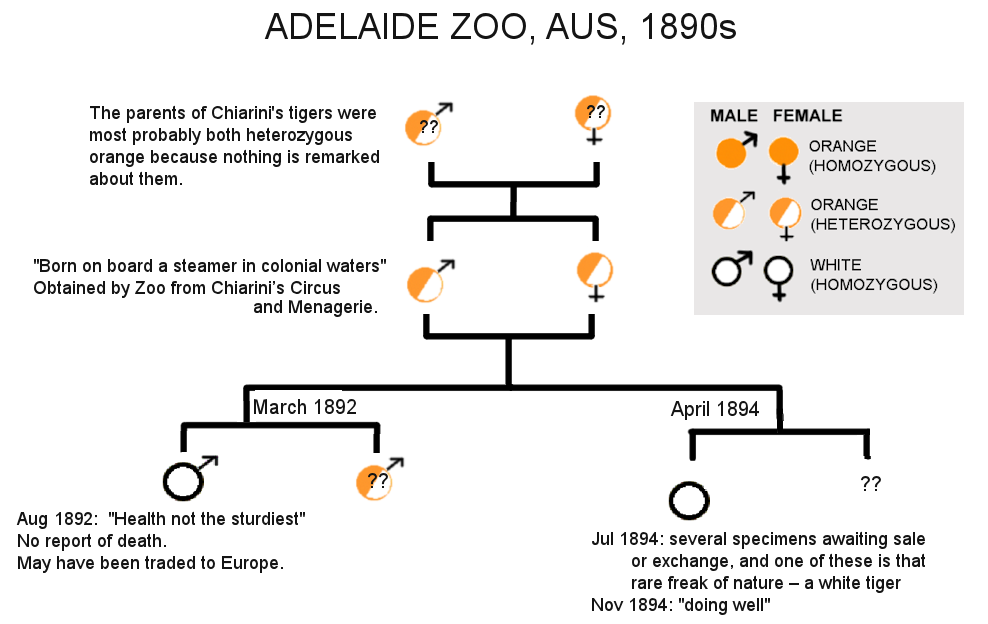
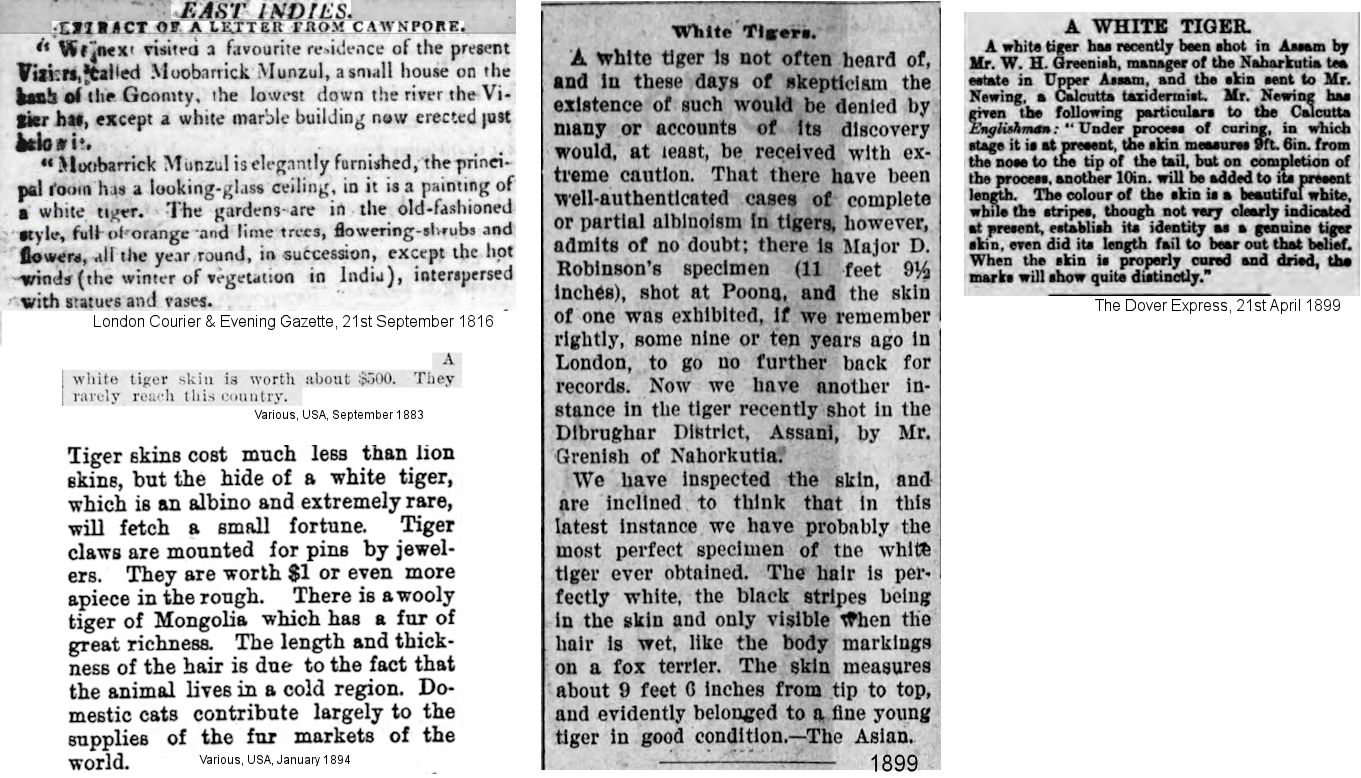
It is interesting that the two great animal dealers of the 19th and early 20th centuries, Charles Jamrach and Karl Hagenbeck never head white tigers among their many curiosities. In Hagenbeck's case it is understandable: India was part of the British Empire and Hagenbeck, being German and operating from Hamburg, had stronger links to German territories in Africa. Although Jamrach was also German, his Emporium was in London, yet there is no record of him ever having white tigers. (Hagenbeck once acquired an unusually large Bengal tigress; it is known that tigers that carry the white gene often grow faster and larger than tigers lacking the gene - could she have been a gene carrier? Sadly we will never know.
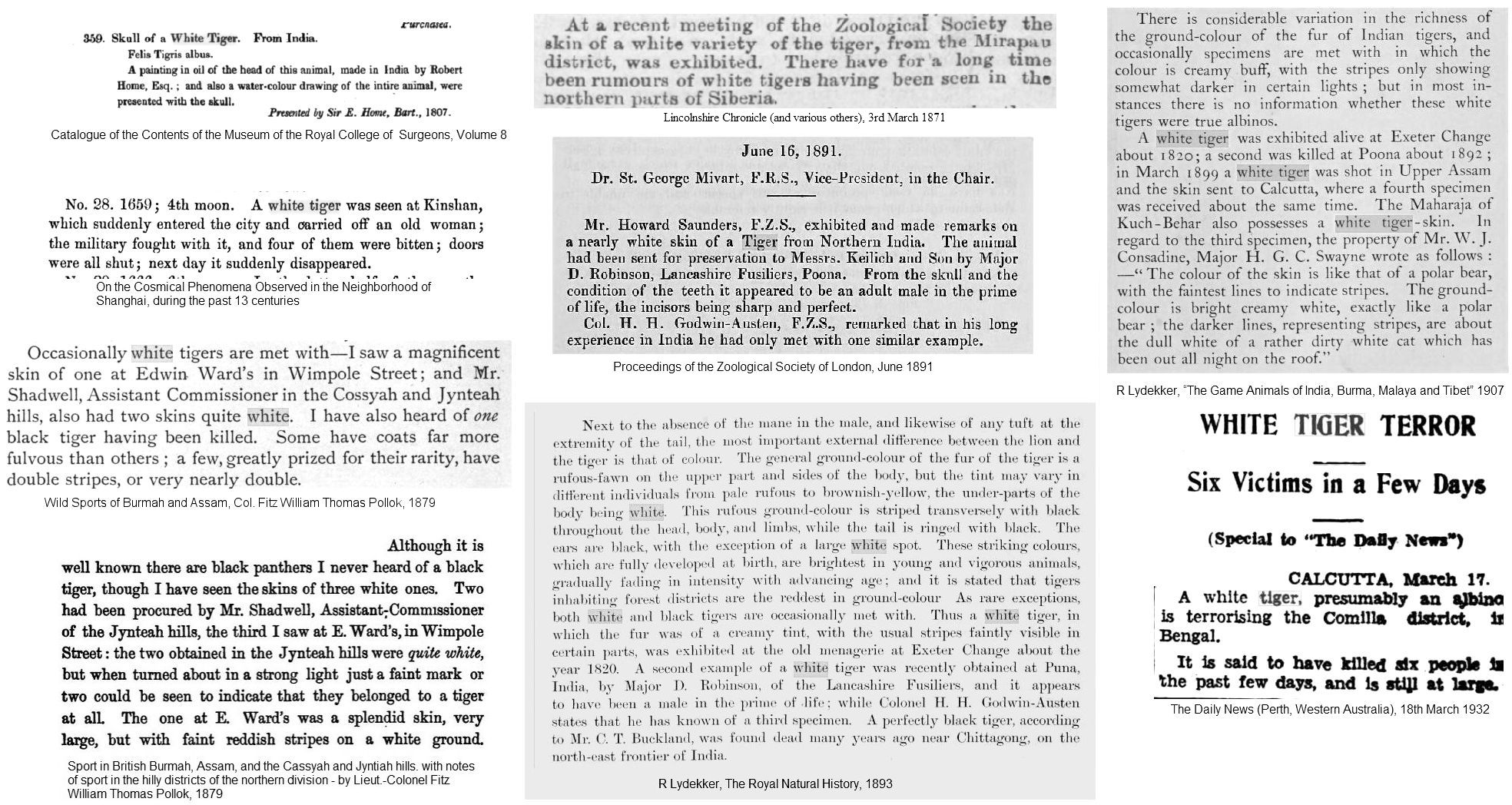
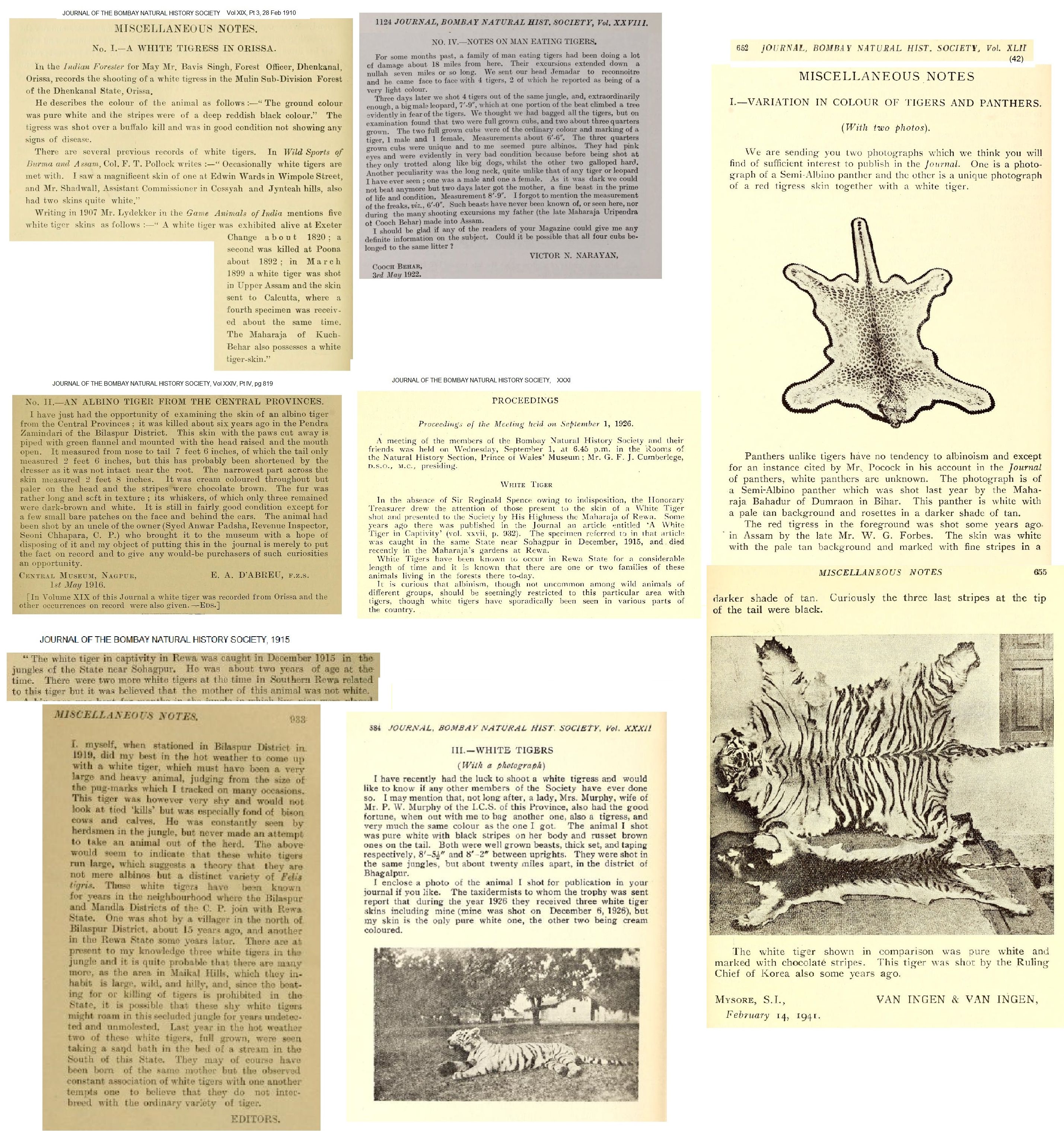
[PURE WHITE TIGER]Bangalore Spectator, 12th August 1885, Times of India, 17th August 1885
Mr. Bassuppajee Urs, I hear, has been informed that a "white tiger," without any marks about it, has recently been seen in these jungles. How far the animal really answers this description we can, of course, only imagine, as terrified and superstitious natives cannot always be depended upon in such matters. However, the Military Buckshee has resolved to go in search of this strange animal, and if it be really of such an extraordinary appearance, as has been described, to endeavour to capture it alive, and send it to the Menagerie, at Bangalore, in the name of His Highness the Maharajah.
A WHITE TIGER Bangalore Spectator, 1st August 1891
A white tiger is indeed a great rarity. Nevertheless, at the last meeting of the Zoological Society, Mr. Howard Saunders exhibited the skin of an adult male animal which had been shot by Major D. Robinson, of the Lancashire Fusiliers, at Poona. Major Godwin Austin, who spoke on the subject, mentioned his having killed one on the Khasia Hills, and alluded to another as having been shewn at the society's meetings many years ago. It is not said whether these were albinos, like out pure white cat a good example of the carnivore type. In the ordinary tiger the ground tint is of a rich brown or tawny have, with deep black cross stripes. Major Robinson's skin was remarkable in that the ground tint was whitish grey (in this resembling the snow leopard), with very faint brownish cross stripes, not solid as in the ordinary tiger, but each split in the back joining towards bely. No case of a black tiger is recorded, though black leopards are not uncommon, several specimens having been alive at the "Zoo." English Mail.
A WHITE TIGEREnglishman's Overland Mail, 16th March 1899
To the Editor of the "Englishman."
Sir, - Have you or any of your sporting readers, such as H.H. the Maharaja of Kuch Behar, Mr. Nolan, Commissioner of Darjiling, and various others ever seen or heard of a "white tiger"? Such an animal was lately shot in the Dibrugarh District, Assam. He was over nine feet long, in the prime of life and pink of perfection. The gentleman who is the fortunate owner of this wonder has sent the skin down to Mr.Newing, the taxidermist, at Calcutta to be cured, where anyone doubting such an animal or wishing to see it can de so. It is well worth a drive to see such a curiosity. - Sportsman, Assam, Mar. 1
To the Editor of the "Englishman."
Sir, - Though extremely rare white tigers are not unknown. Early in the century a specimen was on view at Exeter Change and was figured by Griffith for Cuvier. Another was obtained by Major Robinson of the Lancashire Fusiliers near Puna, and either this one er another has been recorded by Mr. Howard Saunders (P.I.S., 1891). Colonel Godwin Austen was aware of yet another specimen. Black tigers are still more rare; a single specimen seen by Mr. C.T. Buckland near Chittagong being the only one on record. - Mahendralala Mitra, F.S.Sc., 48, Raja R. Mitra's Road, Calcutta, 10th March.
A WHITE TIGER Cannock Chase Courier, 22nd April 1899
A white tiger has recently been shot in Assam by Mr. W.H. Greenish, manager of the Nabarkutia tea estate in Upper Assam, and the skin sent to Mr. Newing, a Calcutta taxidermist. Mr. Newing has given the following particulars to the Calcutta "Englishman": "Under process of curing, in which stage it is at present, the skin measures 9ft 6in from the nose to the tip of the tail, but on completion of the process, another 10in will be added to its present length. The colour of the skin is a beautiful white, while the stripes, though not very clearly indicated at present, establish its identity as a genuine tiger skin, even did its length fail to bear out that belief. When the skin is properly cured and dried, the marks will show quite distinctly."
A WHITE TIGER SKIN Englishman's Overland Mail, 26th October 1899
A good deal of interest was displayed among sportsmen when, a short time ago, it was announced in this paper that a white tiger had been shot in Assam. As will be seen from our advertisement columns, the skin of this animal is now for sale, and will no doubt be eagerly sought after by those in search of rare specimens. His Excellency. the Viceroy has expressed a desire to see the skin when he comes to Calcutta.
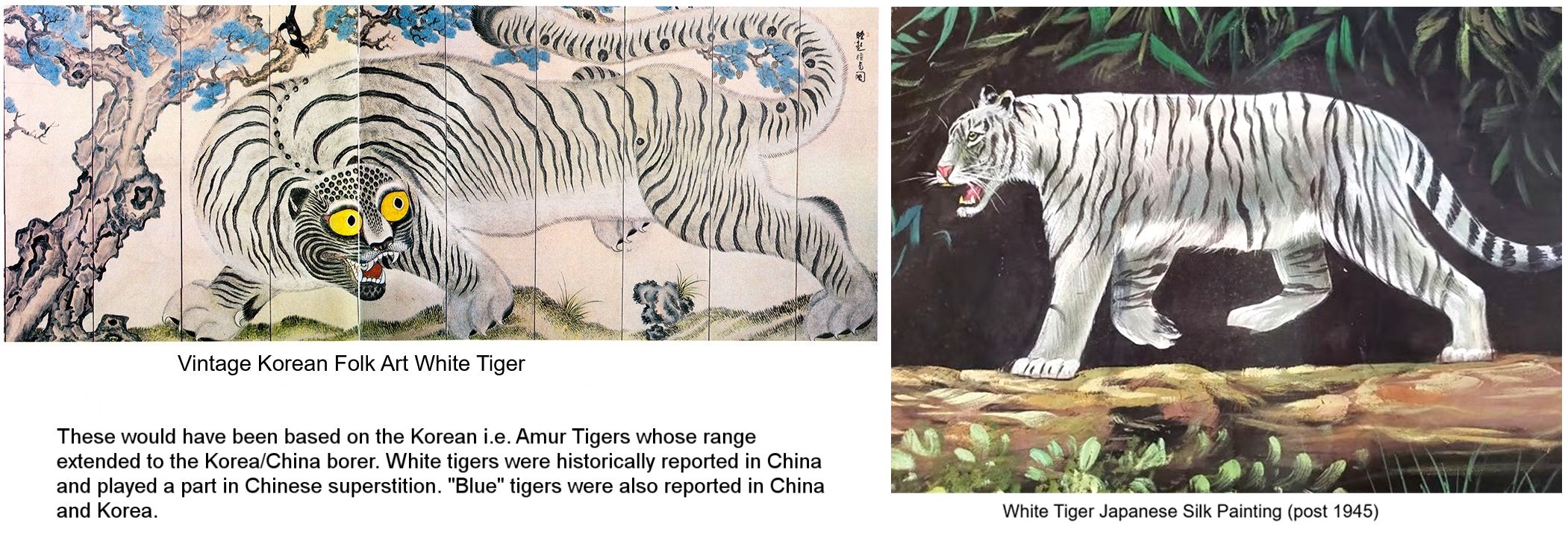
Textual content is licensed under the GFDL.
Albino tigers (Cooch Behar)
Narayan, V. N. 1924. Number of cubs in a tiger's litter. J. Bombay Nat. Hist. Soc., 28:1124.
Pocock RI, 1939. Fauna of British India, including Ceylon and Burma. Mammalia, vol. 1. Primates and Carnivora. Taylor and Francis Ltd., London, 464 pp.
White tigers (Orissa, Bilaspur, Rewa, Bhagalpoore, North Bengal, Assam and Korea)
Blanford, WT. The Fauna of British India, including Ceylon and Burma. Mammalia, 1889
Buchanan, Dr Francis. A geographical, statistical and historical description of the district [. . .] of Dinajpur, 1833.
Cuvier, Georges. 1832. The Animal Kingdom. G. & C. & H. Carvill.
D'Abreu EA. 1916. An Albino Tiger From The Central Provinces JBNHS, Vol XXIV, Pt IV, pg 819
Divyabhanusinh, 1993. Mutant Leopards from India. Journal of the Bombay Natural History Society (JBNHS)
Dunbar Brander AA. 1923. Wild Animals In Central India.
Evans Gordon (Capt). 1921. A White Tiger In Captivity (With A Photo). JBNHS, Vol. XXVII, Pt IV, pg. 932
Gee, E. P. 1959. Albinism and partial albinism in tigers. JBNHS., 56:581-587.
Hamilton, Walter. The East-India Gazetteer, Vol 1. 1828
Kinnear, NB. "The past and present distribution of the lion in south eastern Asia," JBNHS. 27: 34 39 (1920)
Lydekker, Richard. 1893. The Royal Natural History. Frederick Warne.
Martin, Robert Montgomery. The History, Antiquities, Topography and Statistics of Eastern India (Bhagulpoor, Goruckpoor, and Dinajepoor Vol 2) 1838
Mishra, Swati Wilderness Diagnosis, 2001: What Is the White Bengal Tiger's Future? Action BioScience.
Pocock RI, 1929. Tigers. J. Bombay Nat. Hist. Soc., 33:505-541.
Pocock RI, 1939. Fauna of British India, including Ceylon and Burma. Mammalia, vol. 1. Primates and Carnivora. Taylor and Francis Ltd., London, 464 pp.
Pollok, FT. Wild Sports of Burmah and Assam. 1879
Thornton, Edward. A Gazetteer of the Territories Under the Government of the East-India Company: And of the Native States on the Continent of India, Volume 2 . 1858
Thornton, I. W. B., K. K. Yeung, and K. S. Sankhala. 1967. The genetics of the white tigers of Rewa. J. Zool. (London), 152:127-135.
Weigel, I. 1961. Das Fellmuster der wildlebenden Katzenarten und der Hauskatze in vergleichender und stammesgeschichtlicher Hinsicht. S ugetierk. Mitt., 9 (Sonderheft):1-120.
Wolfe, Alan L. The Pictorial Museum of Animated Nature, 1844.
Genetics of Chinchilla and Albino
Robinson's Genetics for Cat Breeders & Veterinarians 4th Ed (the current version)FOOTNOTE
Most white tiger websites have a pro- or anti-agenda and variously claim to give "facts," "truths" or debunk "myths" but give misinformation or have hidden agendas. I stick to facts and deductions based on facts. Some information is documented, some is from personal correspondence with zoos, and some is from the recollections or personal notes of people involved with circus or zoo tigers where records were have been lost or destroyed. Even the different editions of tiger studbooks are inconsistent. Information from my pages, which are frequently updated, is widely copied on those other sites. Some sites have tried to claim I copied their work.
|
BACK TO HYBRID & MUTANT BIG CATS INDEX |